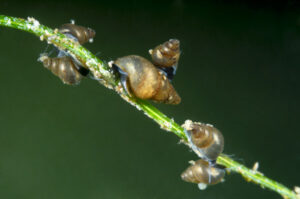
 Maria bestaat!! Ze leeft in de Boschmolenplas. Een heel klein slakje uit de Boschmolenplas verricht een wonder. Het gaat hier om Jenkins waterhorentje (Potamopyrgus antipodarum).Het schelpje is maar 6,5mm bij 3,5mm groot. Het slakje zelf is grijs met lichtere tentakels. Ze zitten werkelijk overal op, aan en onder. Oorspronkelijk komt de soort uit Nieuw Zeeland. In het warme gedeelte van het jaar kunnen ze zo massaal voorkomen dat waterplanten er bijna zwart van zien.
Maria bestaat!! Ze leeft in de Boschmolenplas. Een heel klein slakje uit de Boschmolenplas verricht een wonder. Het gaat hier om Jenkins waterhorentje (Potamopyrgus antipodarum).Het schelpje is maar 6,5mm bij 3,5mm groot. Het slakje zelf is grijs met lichtere tentakels. Ze zitten werkelijk overal op, aan en onder. Oorspronkelijk komt de soort uit Nieuw Zeeland. In het warme gedeelte van het jaar kunnen ze zo massaal voorkomen dat waterplanten er bijna zwart van zien.
In de winter is hun aantal aanzienlijk minder maar je hoeft niet echt te zoeken om ze tegen te komen. Er zijn geen andere slakjes waar je ze mee kunt verwarren.
Wat is er nu zo bijzonder aan dit slakje? Nou, Jenkins waterhorentje is parthenogenetisch ovovivipaar………………….ja, dat dacht ik ook. Moest zelfs even oefenen voordat ik het uit kon spreken. Maar dit is het wonder. Parthenogenetisch wil zeggen dat ze zich ongeslachtelijk kunnen voortplanten. Ze hebben dus geen mannetje nodig om jongen te krijgen! Ovovivipaar wil zeggen: eierlevendbarend. De eitjes komen in het moederdier uit, er komen levende jongen ter wereld. Een hele prestatie als je zonder mannetjes jongen ter wereld kunt brengen.
Natuurlijk zijn er ook enkele nadeeltjes. Omdat er geen uitwisseling is van genetisch materiaal zijn alle dieren genetisch identiek. Bij een ziekte of parasieten bestaat de kans dat een hele populatie uitgeroeid wordt. Daar is ook wat op gevonden. Er bestaan wel mannetjes van deze soort maar ze zijn zeer zeldzaam. Geslachtelijke voortplanting komt dan ook sporadisch voor. Misschien net genoeg om zoveel genetische variatie te krijgen dat de soort niet uitsterft bij ziekte of parasieten.
Nu mag je twijfels hebben bij Maria maar in het dierenrijk is ongeslachtelijke voortplanting niet echt een uitzondering. Het komt voor bij reptielen, insecten en zelfs vissen. In onze Boschmolenplas is dit kleine slakje daar een voorbeeld van.

Tekst en Foto’s Silvia Waajen
A very little snail from the Boschmolenplas performs a miracle. It’s about the New Zealand Mud snail (Potamopyrgus antipodarum). The shell is only 6,5mm by 3,5mm in size. The snail itself is grey with lighter tentacles. They are actually on and under everything. It originates from New Zealand. In the warm part of the year they can be in such big numbers that water plants look almost black. In wintertime their numbers are considerably less but you don’t really have to search to find them. There are no other snails to confuse them with.
What’s so special about this snail? Well, the New Zealand mud snail is parthenogenetic ovoviviparous……………yes, that’s what I thought. Even had to practice before I could pronounce it. But this is the miracle. Parthenogenetic means, they can reproduce without mating. So they don’t need a male to get offspring! Ovoviviparous means: the eggs hatch in the body and then the offspring is born alive. Big achievement to get offspring without a male.
Of course there are some disadvantages. Because there is no exchange of genetic material, all snails are genetic identical. In case of a disease or parasites there is a chance the whole population will be wiped out. Here is also a solution. Males of this species do exist but they are very rear. Sexual reproduction occurs but is very uncommon. Maybe just enough to get that genetic variation to prevent the species from extinction by disease of parasites.
You may have your doubts about Mary but in the animal kingdom parthenogenetic reproduction isn’t that uncommon. It is known for reptiles, insects and even fish. In our own Boschmolenplas, this little snail is an example.
Zorgeloos duiken en snorkelen begint bij Scuba Adventures Europe. Wij helpen jou de onderwaterwereld te ontdekken met een duikuitrusting die naadloos aansluit op jouw wensen en behoeften.
In onze online en offline duikwinkels vind je als duiker alle benodigdheden om van iedere duik een onvergetelijke ervaring te maken.